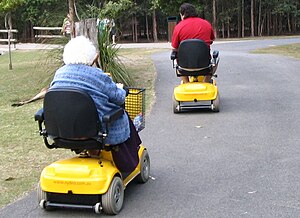Mobility scooter
Contents |
Description
A mobility scooter has a seat over 3 or 4 wheels, a flat area for the feet, and handlebars in front to turn one or two steerable wheels. The seat may swivel to allow access when the front is blocked by the handlebars. Mobility scooters are usually battery powered. A battery or two is stored on board the scooter and is charged via an onboard or separate battery charger unit from standard electric power. Gasoline-powered scooters may also available in some countries, though they are rapidly being replaced by electric models. Do not confuse a mobility scooter with a wheelchair as they are for very different needsThe tiller, with forward/reverse directions and speed controls, is the steering column centrally located at the front of the scooter. Forward/reverse direction can be controlled by thumb paddles, finger controls, or a switch. There are two types of mobility scooters: front-wheel drive (FD) or rear-wheel drive (RD). The FD is usually a smaller device and is best used indoors. Rider weight capacity is generally upwards to 250 pounds maximum. The RD is used both indoors and outdoors with rider weight capacity of 350 pounds. A heavy duty rear-drive can carry up to 500 pounds, varying by manufacturer.
Allan R. Thieme invented the first mobility scooter in 1968, in Bridgeport, Michigan. Thieme was personally motivated to create this product to help a family member diagnosed with multiple sclerosis. This first mobility scooter, a front-wheel drive model, was conceived and built at his home. The Amigo, as it was brand-named, initiated the entire “scooter” industry. Today, Amigo Mobility International Inc headquarters are located in Bridgeport, Mich.
Advantages
Assistive and small sit-down motor scooters provide important advantages to people with mobility problems throughout the world. A scooter is useful for persons without the stamina or arm/shoulder flexibility necessary to use a manual wheelchair. Also, swiveling the seat of an electric scooter is generally easier than moving the foot supports on most conventional wheelchairs. A mobility scooter is very helpful for persons with systemic or whole-body disabling conditions (coronary or lung issues, some forms of arthritis, obesity, etc.) who are still able to stand and walk a few steps, sit upright without torso support, and control the steering tiller.A major selling point of mobility scooters for many users is that they do not look like a wheelchair, disability still being seen by many as a negative or somehow shameful. Mobility scooters are in general more affordable than powered wheelchairs, leading to them being procured as a cheaper alternative.
Limitations
While a mobility scooter eliminates much of the manual strength problems of an unpowered wheelchair, its tiller steering mechanism still requires upright posture, shoulder and hand strength, and some upper-body mobility and strength. The arm-rest mounted controller typical of powerchair designs may be more suitable for many users. Other drawbacks of mobility scooters are their longer length, which limits their turning radius and ability to use some lifts or wheelchair-designed access technologies such as kneeling bus lifts. Often a mobility scooter has a low ground clearance which can make it difficult to navigate certain obstacles, such as travelling in cities without proper curb cuts. Navigating in restricted spaces, whether in the home or in public spaces and buildings can also be a problem. Scooters also have fewer options for body support, such as head or leg rests. They are rarely designed for ease of patient transfer from seat to bed. These limitations may prevent some disabled individuals from using scooters. In addition, scooter limitations may vary depending on model and manufacturer. A limitation of one make/model does not necessarily carry over to all. Individual needs may affect the suitability of a particular model.Currently in the United States, Medicare will not approve a power wheelchair for persons who do not need to use the chair "inside their own home", even if their medical needs restrict the use of a mobility scooter. For example, a person with severe arthritis of both shoulders and hands may not be the best candidate for a scooter, but because they can walk a few steps in their own home, such persons are not seen as approved candidates for a power wheelchair either. Various disability rights groups are campaigning for Medicare to change this policy. For those who do qualify for Medicare, they can reimburse up to 80% of the total value of the scooter.[1]
Similar restrictions on NHS powerchair provision exist in the UK, with manual wheelchairs prescribed for users with any ability to walk. This has led to many users who might be better served by a powerchair privately procuring a mobility scooter as a cheaper substitute.
Legal issues
In the UK mobility scooters are classified by The Use of Invalid Carriages on Highways Regulations 1988 as either Class II or Class III Invalid Carriages for legal purposes. A Class II scooter must be limited to 4 mph for use on a footway only, while a Class III scooter must be limited to 8 mph for road/highway use and have an additional 4 mph limiter for footway use. As of March 2010 a government consultation is underway to determine how the law should adapt to increasing scooter use, whether higher road speeds should be allowed and on a replacement for the archaic term 'invalid carriage'. Due to concerns over safety issues and problems with bringing prosecutions against irresponsible users under existing laws, the consultation will also consider whether to make third party insurance mandatory, consider the introduction of compulsory training for users and discuss how to bring scooter users under wider road traffic legislations.Disability Bracknell told the Committee about four deaths resulting from mobility scooter accidents in one year in Bracknell alone, but there is little evidence to suggest that fatalities on this scale are replicated nationwide.[2]

